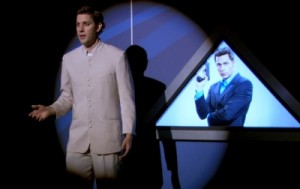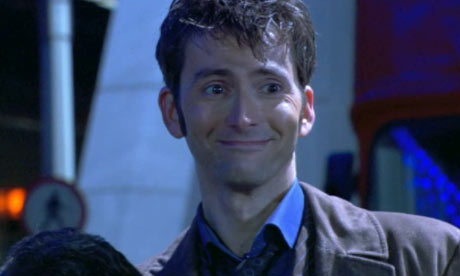
John Krasinski in one of The Office's lower moments
This will hardly come as a surprise to anyone paying attention, but the American edition of The Office on NBC and How I Met Your Mother on CBS are closer to their last episode than their first. What might surprise some is just how badly these two mainstays of American TV comedy of the past decade are showing their age. In the past two months both shows lumbered across the finish line, wrapping up their most recent seasons, eighth for The Office and seventh for How I Met You Mother to little acclaim. In fact, much of the conversation about both have centered around questions as to why the series are even bothering to continue producing new episodes. Debates about the quality of the shows’ current output or their future endeavors aside, the twinned declines of The Office and How I Met Your Mother provide insight into the way American television creates and sustains comedies and why so many fall apart under their own weight.
The Office and How I Met Your Mother debuted only a few months apart in 2005, and quickly the kind of critically acclaimed but lightly viewed comedies that had popped up and been snuffed out, off and on, since I Love Lucy blazed the trail for TV comedy in the 1950s. The Office’s mockumentary style and cringe-inducing humor were lifted wholesale from its British predecessor, and when combined with a cast of reliable comedic talent led by Steve Carrell, lent the show much of its appeal. How I Met Your Mother was more traditional in its style and humor, it is a 3-camera sitcom shot primarily on 2 sets, much like Seinfeld, Cheers, and most every mega-popular sitcom since the aforementioned Lucy. Where it differed was in its narrative structure, centered on a framing device of a middle-aged dad in the 2030s telling his kids about how he met their mother, the show specialized in plots that featured heavy doses of asides and callbacks. Most every episode involved some kind of storytelling derring-do, having as much fun in the telling of its story as it did in the actual contents of the story.
Both shows then, had notable differences from the generation of mega-popular sitcoms that were being retired as they came on the air. Friends, Frasier, and Everybody Loves Raymond, shows that had won both massive audiences and critical acclaim, all left the air in 2004 or 2005, and left no clear successor in their wake. Shows like Arrested Development had won wide acclaim but not broken through with audiences, and both The Office and HIMYM more or less followed in that show’s footprints. They carved out a niche on their respective networks, produced consistently high-quality episodes for about 4 seasons, but never broke through as true water cooler hits. They were something more than cult hits and something less than comedy blockbusters, and in an era when TV in general was bleeding viewers every week that was good enough.
Even at the peaks of their popularity and acclaim though, both shows suffered from some notable flaws. The Office’s mockumentary format meant that the Dunder Mifflin workers that TV audiences got to know so well were aware of their role as TV characters, since the premise of the show was that a documentary was being filmed about this particular office. This meant that the rhythms and agonies of everyday office life could be filmed realistically, and lent much to the blooming romance between Jim and Pam that defined so much of the first few seasons. However, it also meant that when the characters acted stupidly or unbelievably it tested credulity in ways that characters in a more typical sitcom would not. When Dwight climbed on the roof of a house during a corporate party to test the sturdiness of the chimney’s masonry or Michael camped in the woods to prove his managerial mettle it elicited as much eye-rolling as chuckling. No fools could truly act so foolishly in real life without sever repercussions, and since we were meant to believe that this was a real office such antics often acted as a drag on the show. This also lead to the writers taking liberties with the characters, changing their motivations and actions from week to week so as to meet the needs of being simultaneously ‘real’ and characters on a sitcom (i.e. the weekly guessing game of how smart Carrell’s Michael Scott or Ellie Kemper’s Erin Hannon were from week to week).
How I Met Your Mother’s unique narrative format also acted as an occasional wrench in much the same way. While individual episodes thrived on the narrative play, such as the sublime Pineapple Incident episode, increasingly the over-arcing narrative became a weight around the show’s neck. The initial seasons were thrilling in their ability to weave a great romance through the protagonist Ted’s everyday life with his friends. Hints of his future happiness would be dropped, and the audience has great fun guessing whether or not this girlfriend or that ex would become the much-awaited mother. As the series entered its 5th and 6th seasons though, and the search for his future wife dragged on with much repetition and only hints towards some kind of resolution, any sense of overall narrative momentum was lost.
For both The Office and How I Met Your Mother these troubling tendencies came to a head in the 2011-2012 television season. On The Office the departure of Steve Carrell from his leading role left the series utterly rudderless. Carrell’s performance had held together many episodes through sheer force of will, and the writers failed to prepare themselves for what was in essence a series reboot by writing all of the supporting characters into corners that did not allow them to step into the spotlight. The central couple of Jim and Pam were ensconced in family-building, having flirted with greater responsibilities or opportunities but failed to pursue them. Other characters, like Dwight or Andy had been under-served in the past, turned into weak caricatures of recognizable types that could not rise into the spotlight. This meant that the show spent most of the past season searching in vain for some vein of comedy to mine, taking turns with romance, corporate satire, and other plot shakeups but none took hold. The show’s core conceit had been stretched too thin, the characters had run out of stories, and the show spent each week wallowing around. It attempted to redo formerly winning plot-lines, perhaps most notably a retread of season five’s Michael Scott Paper Company. In the final few weeks it seemed to depart from recognizable office politics entirely, creating utterly unrealistic narrative twists like Catherine Tate’s odd Nellie usurping Ed Helm’s Andy simply by moving into his office.
On How I Met Your Mother the necessities of the over-arcing narrative meant that that show also fell back on old plot-lines. Cobie Smulder’s Robin briefly revived her romantic feelings towards both Neil Patrick Harris’s Barney and Josh Radnor’s Ted. Marshall and Lily (Jason Segel and Alyson Hannigan), the show’s resident married couple, spent the season vacillating on where to live suburbs vs. city) and how to start a family (baby now?), but without any real sense of play. For the most part, the show simply spun its wheels, introducing one-off characters and somewhat lazily wasting time while waiting for the Mother’s eventual reveal (presumed to be in the series’ final episode, which may be years in the future). A few episodes stood out, most notably the wrenching Symphony of Illumination, when Robin dealt with the news that she was infertile and would never have children by addressing narration to her imagined, never-to-be, children. But for much of the season viewers were treated to seeing Barney deal with becoming less a sociopath for the fourth straight season and Ted drifting ever deeper into outright douchbaggery, neither of which felt fresh or winning.
The problems in both shows latest seasons are, in essence, representations of the structural supports of nearly every American TV comedy. TV sitcoms are built on a very solid narrative structure. In essence, the show’s basic premise (documentary filmed in small office or dad tells his kids how he met their mom) must be maintained episode to episode. This means that the overall narrative can only move at a glacial pace, so as to make sure that the balance of the basic premise is not too upset. If Ted meets the mother while grabbing coffee one morning or the denizens of the office go about their jobs without comedic hi-jinks the entire endeavor could become dangerously unfamiliar to the audience. Since TV networks want their shows to appeal to as many viewers as possible, this means that no one in the audience who is even vaguely familiar with the series should ever be lost as to what is going on in a particular episode. This works well enough for 50-75 episodes, but eventually the bloom comes off the rose and what once was fresh suddenly seems endlessly dull. Because of this, neither The Office nor How I Met Your Mother have been able to grow or change organically. Stuck in this strange stasis of a long-running sitcom world, they have responded by disappointing many of those who once loved them. Such a fate is hard to endure for a fan of any once-great show, but until every TV executive decides that the way to make money is to emulate the narrative chutzpah of outre series like Mad Men or Louie (about which more will be said in later essays from yours truly) it will befall many more series in the future.











